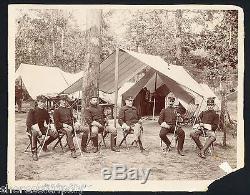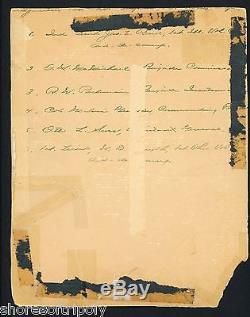
- Homepage
- Conflict
- Format
- Albumen (3)
- Ambrotype (32)
- Cabinet Card (67)
- Cdv (5)
- Crayon Portrait (2)
- Daguerreotype (27)
- Hardcover (14)
- Multi-formats (6)
- Negative Photo Image (4)
- Photograph (6)
- Ruby Ambrotype (3)
- Sixth Plate (2)
- Small (2)
- Stereoview (3)
- Tin Type (8)
- Tin Type Photo (2)
- Tintype (157)
- Tintype Photograph (6)
- Unknown (9)
- ... (6650)
- Photo Type
- Album (9)
- Albumen (14)
- Ambrotype (199)
- Cabinet Photo (67)
- Cdv (479)
- Cdv & Tintype (6)
- Cdvs & Tintypes (7)
- Daguerreotype (84)
- Gelatin Silver (13)
- Mixed (3)
- Negative (10)
- Negative Photo (4)
- Opalotype (4)
- Other (4)
- Photograph (4)
- Snapshot (3)
- Stereoview (23)
- Tintype (525)
- Tintypes (3)
- Unknown (12)
- ... (5535)
- Theme
- Americana (41)
- Americana, Fashion (18)
- Americana, Militaria (17)
- Antique (8)
- Art (7)
- Civil War (14)
- Conflicts & Wars (6)
- Fashion (19)
- History (43)
- History, Militaria (10)
- Love (6)
- Militaria (1033)
- Patriotic (7)
- People (21)
- Politics (14)
- Portrait (67)
- Portrait, Man (22)
- Stamps (22)
- Travel (6)
- Victorian (7)
- ... (5620)
- Type
- Belt Buckle (3)
- Carte De Visite (2)
- Cdv (3)
- Cdv Photograph (14)
- Daguerreotype (3)
- Full Cdv Photo Album (2)
- Illustrated Book (3)
- Negative Film Photo (4)
- Pendant (3)
- Photo Album (3)
- Photo Frame (2)
- Photograph (1350)
- Photograph Album (49)
- Picture Book (8)
- Picture Frames (8)
- Print (3)
- Real Photo (rppc) (10)
- Tintype (9)
- Tintype Photo (4)
- ... (5525)
- Unit Of Sale
Col. Grigsby Cowboys Andersonville Pow CIVIL War Soldier Otto Original Photo




MELVIN GRIGSBY at camp headquarters surrounded by others identified on the back. The clarity of this photo, that dates to the late 1800's, is fantastic!!! One of the men (second in from the right) is OTTO L. SUES who participated in the Geronimo Indian campaign and went on to write and publish the book GRIGSBY'S COWBOYS. The photo measures approximately 10.25" x 8".
In some cases, photos are enlarged to show detail. There are two pieces of tape off to the left side on front (hard to see). There is also archival tape on back to help preserve. Please see photos for reference.
The other men in the photo (left to right) are. FORSYTH - 1st Lieutenant Ohio Vol - Aid-de-Camp. Grigsby was South Dakotas attorney general and the law partner of U. Richard Pettigrew in Sioux Falls.When the United States entered into war with Spain in April 1898 over Cuba securing its freedom fromish rule, Grigsby was one of several people who proposed that volunteer regiments of cowboys be organized to fight the war. Congress passed a measure that authorized three cavalry regiments known as the First, Second and Third U. Theodore Roosevelt was named commander of the First Regiment, Judge Jay L. Torrey of Wyoming commander of the Second Regiment, and Grigsby commander of the Third.
Recently commissioned as a colonel, Grigsby received orders to break his regiment into 12 troops, with five coming from South Dakota, four from Montana, two from North Dakota and one from Nebraska. Grigsby appointed five captains in South Dakota to recruit and organize the individual troops. They were SETH BULLOCK of DEADWOOD to lead Troop A, John Foster of Chamberlain to lead Troop B, George Hair of Belle Fourche to lead Troop C, John Hammond of Sturgis to lead Troop D and Joseph Binder of Pierre to lead Troop E.
Within three weeks, an entire regiment of nearly 1,000 men had been recruited, organized and mustered in. Grigsbys Cowboys, as the Third U. Cavalry Regiment came to be called, was ordered to Chickamauga, Georgia.Located on the site of the Civil War battlefield at Chickamauga, Camp Thomas was one of the largest training camps for troops. Grigsbys Cowboys arrived to find no weapons, uniforms, saddles or bridles, overcrowding and poor sanitary conditions.
Nevertheless, the cowboys trained and became what Sues called a complete military machine. MELVIN GRIGSBY, was born June 8, 1845, at the village of Potosi, Grant county, Wisconsin. When four years of age he moved with his parents on to a farm, where he spent his early youth, attending district and village schools. At the break out of the Civil War in 1861, he was anxious to enlist, but his father thought him too young to enlist, and sent him to the Lancaster Institute at Lancaster, Wisconsin, which, however, did not quench the war fever, and in November, 1861, he enlisted in Co. C, 2nd Wisconsin Cavalry, and remained in active service or in CONFEDERATE PRISONS until April 13, 1865 , when he received his discharge. He was taken prisoner near Vicksburg, and spent eleven months in prison at Canton, Mississippi, Cahaba, Alabama, Andersonville, Georgia, and Florence, South Carolina. About six months of his time he spent in Andersonville. From the last prison at Florence, South Carolina, he escaped on the 10th day of January, 1865, and going south reached Sherman's army on the first day of February. He remained with the army until it reached Goldsboro, and then got permission to accompany General Sherman when he went to Eagle Point to meet General Grant, and from there he came on to Washington and home to Wisconsin. His experience while in prison, inspired him to write a book titled Smoked Yank, which brought him considerable notoriety.After leaving the army he attended the university at Madison, Wisconsin, one year, and in 1866 went to the Normal school at Platteville, Wisconsin, where he remained until he graduated in 1869. He then was employed for one year as principal of the public schools at Horicon, Wisconsin, and held the same position at Darlington and also at Delevan in that state. During this time he had studied law, and at the end of his career as a teacher he entered the law office of Pitt Dewey at Lancaster.
In the spring of 1872, he was admitted to the bar, and immediately thereafter started out on horseback in search of a place in which to locate. He arrived in Sioux Falls the first Sunday in June, and soon settled the question of residence in favor of this place. He entered into a co-partnership with R.
Pettigrew for the practice of law and in the real estate business, which continued until the fall of 187? In 1877, in connection with Geo. Smith remained in co-partnership with Mr. Grigsby for nearly six years, during which time they started the Bank of Egan, at Egan, South Dakota, with Mr. Grigsby as President for the first year. He also started the Union County Bank at Elk Point, and was its first President; was one of the principal promoters of the Dakota National Bank in Sioux Falls, and was its first President. He had a very active political life.In 1886, the Minnehaha county republican convention instructed its delegates to the territorial congressional convention to present his name to the convention for nomination. In 1886, he was a pronounced candidate for the congressional nomination. The convention was held at Watertown, and it was one of the notable conventions of territorial days.
He had a large following and nearly votes enough to secure the nomination. The same year he was elected to the territorial council, and served in that capacity with marked ability. He was elected alderman from the Third ward at the first city election in 1883, and the same year was a delegate to the constitutional convention held at Sioux Falls, September 4. Up to the time of the holding of the republican state convention in 1894, he had been a Republican, but not liking the financial plank in the republican platform he joined the Populists, believing the free coinage of silver to be the most important issue before the American people. He was nominated by the party of his adoption for the state senate in 1894, but went down before the republican majority which swept the political ranks in Minnehaha county that year. In 1896 he was nominated on the populist state ticket for attorney general. He stumped the state for Bryan and free silver, and when the votes were canvassed he had the pleasure of knowing that he had more votes than any other candidate upon the ticket in his own county and in the state. April 11, he went to Washington, where he learned that a bill inspired by Theodore Roosevelt was before Congress providing for the organization of a regiment of cowboys. Seeing that only one regiment of special volunteers could be raised under the provisions of the bill, Grigsby had his friends among the congressmen during the last forty minutes before a vote was taken propose an amendment which was adopted authorizing the secretary of war to organize companies, troops, battalions or regiments possessing special qualifications from the Nation at large, including the appointment of the officers thereof. This bill was passed on April 22, and a week later he received his commission as colonel, with instructions to recruit the regiment of the Third United States Volunteer Cavalry.His force was mustered into service May 19, and the next day left for Chickamauga, the southern rendezvous. This regiment, known as "Grigsby's Cowboys" was a splendid regiment, and before long had the reputation of being the best drilled and equipped of any at the park, and was frequently compared with Col. Roosevelt's regiment, known as "Teddv's Terrors, " who did valiant service in front of Santiago, and made its colonel governor of New York.
But, to the great disappointment of not only Col. Grigsby but of the entire regiment, the war was brought to a close without this regiment being ordered to the front. But the promptness of Col. Grigsby in not only offering his own services to the government, but in enlisting a body of men inured to hardship, with superior qualifications for the service expected of them, is a tribute to his good judgment, courage and patriotism that will not soon be forgotten in South Dakota (or elsewhere). He was popular with his men, and when the regiment was mustered out its officers presented him with a beautiful sword. During his absence at Chickamauga his son, Sioux K. Credit: "History of Minnehaha County, South Dakota" by Dana R. A great addition to any collection.Mailing is done ONCE per week and day varies depending on orders. Please be sure to check back for additional historical and antique items as Ill be adding items throughout the week.
Please note that I take pride in the historical items offered and do NOT engage in the sale of reproductions! GRIGSBY COWBOYS ANDERSONVILLE POW CIVIL WAR SOLDIER OTTO ORIGINAL PHOTO" is in sale since Thursday, May 08, 2014.
This item is in the category "Collectibles\Photographic Images\Vintage & Antique (Pre-1940)\Other Antique Photographs". The seller is "notesfromaghost" and is located in San Francisco, California. This item can be shipped worldwide.
- Date of Creation: 1880-1889
- Photo Type: Cabinet Photo
- Subject: Figures & Portraits
- Color: Sepia
- Size Type/Largest Dimension: Large (Greater than 10")
- Region of Origin: US

